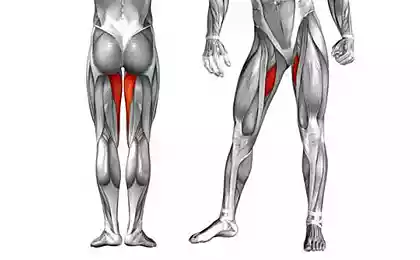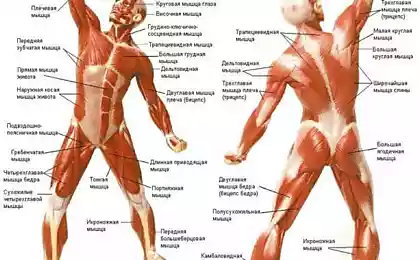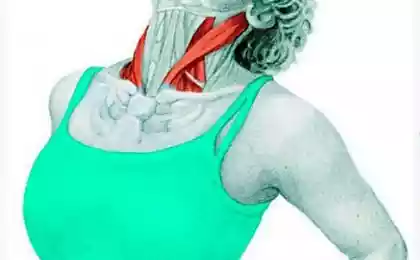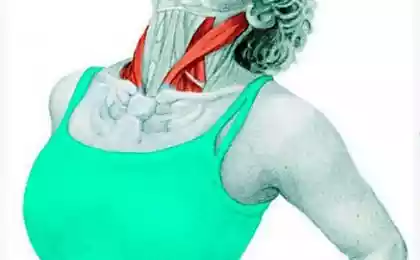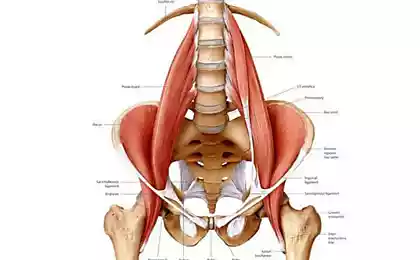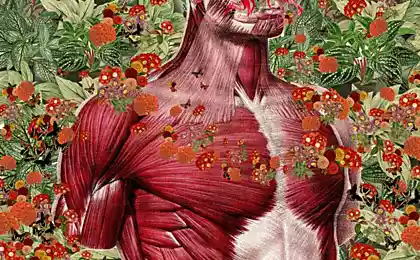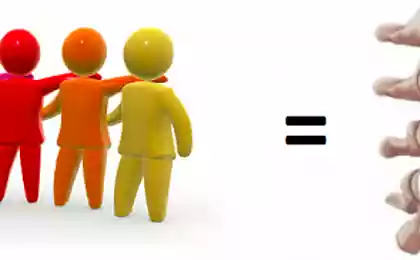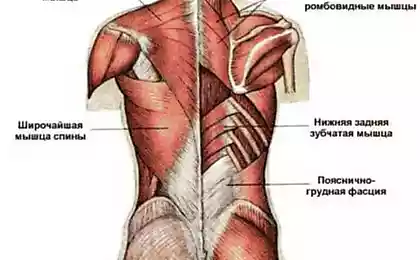721
Exercise for the heart is the main muscle of our body
EXERCISE A HEALTHY HEART
The most important muscle in our body, it is not biceps, and not even the breast. The biggest human muscle is the heart. From his training and size depends on not just your appearance. From this line depends on where you'll lie down after 60 years – on the beach or under the ground. Most people in the head is a mess about the proper training of the heart.

THE HUMAN HEART
Regularly surpassing the blood through the body, it creates such enormous pressure that can push out a jet of blood on a length of 9 meters. The human heart is terribly tough. It constantly, without rest, is reduced, reaching monstrous figures – more than the 40,000,000. reductions per year.
Such a fantastically large load does not pass in vain and is the reason for the grim statistics of cardiovascular diseases in the modern world. "Engines" very often or do not properly use, or destroy "the life" working in the wrong mode.
Meanwhile, to set the heart and to train him very easily. And just below you will learn about correct and effective methods of training the cardiovascular system.
By the way, those who think that they especially don't need to say: do not see the practical importance of the fitness of the heart, then you are very much mistaken, because the trained heart increases functionality and endurance. Sometimes people are very strong physically, and after work 30-60 seconds all sweaty and starts to choke, although the force seems to be in the muscles there.
It especially often happens among those who do martial arts. Look, like a healthy man, and in a minute all red and his mouth open, take it and do with it what you want. Why is this happening?
CARDIOVASCULAR SYSTEM AND ENDURANCE
Heart – in the broad sense an electric "pump", which continuously drives the blood through the tubes (vessels) in our body. This system is called the cardiovascular! Its mission is to provide all the cells and organs of our body with the necessary amount of oxygen and other nutrients necessary for the life. Realizing this, you can see some dependencies are important for understanding the effective functioning of the heart.
The larger the body, the more need for blood; the more blood you need, the more you need the heart, or the more often it should be reduced; the larger the heart the more blood it pumps at a time (more oxygen at a time); the smaller the heart the more one is reduced to pump the desired volume of blood; the larger the heart the less it has to contract to pump the desired volume of blood; The heart rarely decreases – the less it wears out for life.
For athletes, bodybuilders or other strength sports, it's especially important because in our case the situation is complicated by the large number of muscle mass. Every extra 10 kg of muscle requires about 3 litres of supplemental oxygen per minute. The average person 1 liter of blood carries an average of 160 ml of oxygen.
If we multiply this number of oxygen to the amount of blood pumped per minute (which depends on heart rate) you will get the amount of oxygen delivered by the blood per minute. If the load is very intense (180-190 beats per minute), most average people get about 4 litres of oxygen per minute.
Now imagine two twin brothers on a treadmill. Alone weighs 70 kg and the second weighs 80 lbs. so they ran. The first 4 liters of oxygen is quite enough for comfortable running, but the second need for comfort to download not 4, and 6-7 liters of blood (to feed muscles).
And heart if it is the same size as my brother, and declining with the same speed, will not have time to meet all of the organs of sufficient oxygen. The second very quickly begin to choke and be forced to reduce the pace.
How to fix it? Or to reduce oxygen consumption (to lose weight that may not be acceptable), or increase the volume of the heart and blood distilled at a time.
This, indeed, is the meaning of this exercise of the heart to increase its internal volume, but the size. What is the volume of the heart – the more nutrients the heart receives over time; What is the volume of the heart is more – the less it can reduced; the less the heart contracts (working) – the less it wears out.
L AND D –HYPERTROPHY OF THE HEART
Please note, we are talking about increasing the cardiac volume, and not increasing the size of the heart is a very important thing. Because the first is very useful, and second, to turn very bad for you. The fact that hypertrophy of the heart can be good and bad. When the increase is due to the stretching of the walls of the heart muscle (L-hypertrophy) is very good!
This allows for time to pump more blood, which is what we need. But when the heart is growing due to the thickening of the walls of the heart muscle (D – hypertrophy) is very bad. This so-called hypertrophy of the myocardium due to a defect diastole. In General such a common unpleasant thing as a heart attack – the consequences of such changes in the heart.
HOW TO TRAIN THE HEART, RIGHT?
How to achieve a good hypertrophy and avoid the bad? It's very simple. No need to work in the pulse close to the maximum (180-190 beats)! Need to work long, monotonous and often in the middle pulse (110-140) beats per minute. For most often the ideal heart rate of 120-130 beats a minute.
Normal healthy person's resting pulse is 70 beats a minute. When a man begins to do some long cyclic work (practicing with the iron, running or fast walking) — his heart rate starts increasing in order to supply all the organs of the body increased due to the load amount of oxygen.
Here his heart rate reached 130 beats a minute. People in this situation can stabilize the load and continue to work without increasing the intensity. If he continues this exercise for an hour, the "flexibility" of his heart begin to improve.
Muscles will overtake a huge amount of blood through the heart and it will gradually stretch. If you train often (from 2-3 times a week for 30-60 minutes), then over time your heart will expand and its volume will increase significantly. Accordingly will increase the volume of blood pumped in one beat will increase endurance and the number of strokes heart rate at rest will decrease.
How much can you "stretch" the heart? Twice, probably, but 50% is guaranteed. The average person most often, the volume of the heart is equal to about 600 ml. of a skilled athlete 1.200 ml – average common result. Have a unique professional athletes (msmk skiers, joggers) is 1.500-1.800 ml. But this is the level of Olympic champion.
How fast can you "stretch" the heart? For a pronounced effect, it is sufficient for about half a year (6 months) and then maintain that state. At three workouts a week for 60 minutes for half a year the heart is stretched by 30-40%. If you can do these workouts every day, you can count on enlargement of the heart from 50% and above.
In General, there is a very simple rule: the more time during the week, the heart works with the heart rate (120-130) the more and quicker it stretches. With such a "easy" mode of exercise does not occur harmful changes in the heart, about which later. In this mode the heart due to the continuous pumping of large amounts of blood are forced to "stretch out" in volume.
Over time, you will need to increase the intensity of your exercises in order to stay in the area (120-130) of the shock pulse, because your heart will learn to pump more oxygen at a time. The load, which in the beginning was enough to increase pulse to 130 beats per minute, will drop to 120, then 110...100... etc.
HOW TO TRAIN IN PRACTICE?
Your goal: to achieve heart rate to 120-130 beats a minute and maintain the desired heart rate for 60 minutes. To achieve this, it is not necessary to run. Most often the doctor and the trainer suggest it is running in order to train the heart. Why? Perhaps the stereotype and simplicity. No need to explain why — very convenient.
In fact, the heart is to spit and spit, to the heart of an important volume of blood it has to pump to ensure physical activity. And what will physical activity is not important. Importantly, to preserve the desired pulse without "pits" and a strong "peaks".
This can be achieved by training with iron very easily. You will only need to reduce weight and make approaches quite often, so your heart rate could not drop below 110-120 beats per minute. For example: you are doing 10-15 repetitions of bench press, rest 30 seconds (or immediately) make the approach thrust rod in the slope, rest 30 seconds and repeat the procedure again. Five cycles (approaches) will take about 10 minutes. Made six such "dual approach" training and will need 60 minutes in the right heart rate zone.
CARDIOVASCULAR SYSTEM
The alternative can be anything: Boxing, swimming, running, jump rope. Any sufficiently intensive work. You can just have a habit of walking very briskly three times a week at the district. The main thing is to control heart rate.

For heart rate control there are two main ways: simple and fashionable.
The first is that you put the middle finger of the right hand in the area of the left wrist on the inside (at the base of the thumb, it was there that measures your pulse nurse) or in the carotid artery (left side neck) and felt the pulsation count the beats for 6-th seconds (even if you get 10 strikes), then multiply the result by 10 MB to find out the number of beats per minute (10X10=100).
You are to put the middle finger (and thumb have their strong surge and may confuse). The greater the length of time you consider, the more accurate the result. You can count the pulse for 15 seconds and multiply the figure of 4.
More trendy way is to buy a heart rate monitor, which shows you heart rate in real time with an accuracy of ECG. This is a very precise way that will help you cool if you decide to train your heart or burn fat. Because of low loads not only useful for training your heart. They, moreover, lead to the best fat burning.
MYOCARDIAL DYSTROPHY – A DISEASE OF THE "ATHLETIC HEART"
Now let's consider the situation if we increase the intensity above 130 beats a minute. What happens to our heart in terms of the maximum number of cuts? The average load heart in order to pump blood is reduced and stretched fully, relaxing.
This is the "relaxing" between contractions is called diastole. When the intensity of the critical (heart rate 180-200 per minute), the heart is forced to contract very often, and no time to stretch (relax) completely — diastole disappears. Did not have time to relax again need to shrink!
Occurs the internal stress of the heart and blood through it goes bad, which leads to hypoxia and lactic acid. The process is completely the same as when pumping in the muscles. Is acidification which leads to growth of heart walls (hypertrophy). But if acidification will continue for too long or too often – this leads to death (necrosis) of heart cells. It microinfarcts that the athlete usually notices.
All anything, but "dead" heart cells transformed into connective tissue, which is a "dead" ballast (not declining and is a poor conductor of electrical impulses – only prevents). In other words, the heart can be great for some "dead" tissue, and a useful piece of heart (live heart cells) is small.
This is degeneration of the myocardium or the "athletic heart". Myocardial dystrophy develops due to a defect of diastole (heart rate 180-200 per minute) and is the cause of death of many athletes due to cardiac arrest. The majority of deaths occur during sleep. But the cause is still microinfarcts obtained during very intense workouts.
You can often see how teenagers or adult beginners different coach immediately start to drive according to the principle "the stiffer the faster you will get used to it". This is pure full debelizm and lack of knowledge. Be sure to consider the preparedness of the person and the condition of his cardiovascular system. Examples:
Example 1:
Section. Two people: experienced and beginner. The coach gives them intensive work (crossfit, running, sparring, iron - no matter what). But an experienced, heart-trained and has stretched the amount of 1.000 – 1.200 ml. And the newcomer's heart with a volume of 600 ml. Task: what happens? Answer: an experienced heart rate rises to 130 and it without any problems for the benefit of the heart will hold a training session. But the beginner heart rate jumps to 180-200... He is red and gasping for breath. "Let's go!" shouts the coach. "More!". But the heart of a novice at this time is gradually dying, earning microinfarcts due to the effect of diastole. A beginner doesn't train heart, and ruin his earning dystrophy of the myocardium.
Example 2:
Came to training two guys. One weighs 60 kg and second 90 kg. the Level of physical fitness they are the same. Coach therefore gives them the same level of intensity. Question: What will happen? Response: the size of the hearts of the guys are the same (600 ml.), but the size of the "consumers" are different. The first of its size heart enough to be in the range of CHSS 130, but the second you need to "feed" one and a half times more cells! The second with the same load, heart rate 180-200! Microinfarcts and degeneration of the myocardium!
Example 3:
The most common option — people constantly don't do sports, but occasionally I go once a week through the time, and even less likely to play football or basketball. It does not warm up and immediately give yourself ragged temp load! What happens, does it do any good?
Hope you already know the answer! But you can add that "ragged" rhythm is very useful when the heart is stretched, and not Vice versa. A big problem, especially for men, is that they are doing in youth sports seriously or not — sooner or later his throw, but very often, 30 — 45 years abruptly try to repeat their "inborn talents", and the heart is not the same - not trenirovannost a long time, and EGOS that big need to not disappoint and to show the class - here also lies the greatest danger!

HEART AND GYM
Be aware that cell death (myocardial dystrophy) is for life. You will be able to stretch the "alive" part of the heart with the right training in the future, but your "dead" part of the heart you will remain forever and it will always limit the operation of the healthy part.
Often people say, they say exercise with a barbell are harmful to the heart, it is better to run. It is not, because it does not matter what physical activity you are doing. Matters only the level. Should be kept in the desired (useful) for the training load range. By the way a gym in this area is quite a useful thing — the pulse usually does not rise above 130-140 beats.
But the heart of the majority of bodybuilders are usually very weak for two other reasons: the large size of the "consumers" of oxygen at the average size of the heart and a big rest between sets, when the heart rate falls below 100 beats.
The technique of "Breaking shells" of Wilhelm ReichHow to get rid of the ugly of the withers on the back
If bodybuilders trained with shorter rest between sets, they would be smaller, but with much better trained cardiovascular system. On the other hand, the heart of a bodybuilder will often be better trained than the heart of the lover of weightlifting or powerlifting due to the duration of the rest between sets and a sharp explosive loads.
Try to improve observing reasonableness and balance between a healthy heart and the outer beauty and volume of muscles! published
Source: www.ranibu.ru/trenirovka-zdorovogo-serdtsa.html
The most important muscle in our body, it is not biceps, and not even the breast. The biggest human muscle is the heart. From his training and size depends on not just your appearance. From this line depends on where you'll lie down after 60 years – on the beach or under the ground. Most people in the head is a mess about the proper training of the heart.

THE HUMAN HEART
Regularly surpassing the blood through the body, it creates such enormous pressure that can push out a jet of blood on a length of 9 meters. The human heart is terribly tough. It constantly, without rest, is reduced, reaching monstrous figures – more than the 40,000,000. reductions per year.
Such a fantastically large load does not pass in vain and is the reason for the grim statistics of cardiovascular diseases in the modern world. "Engines" very often or do not properly use, or destroy "the life" working in the wrong mode.
Meanwhile, to set the heart and to train him very easily. And just below you will learn about correct and effective methods of training the cardiovascular system.
By the way, those who think that they especially don't need to say: do not see the practical importance of the fitness of the heart, then you are very much mistaken, because the trained heart increases functionality and endurance. Sometimes people are very strong physically, and after work 30-60 seconds all sweaty and starts to choke, although the force seems to be in the muscles there.
It especially often happens among those who do martial arts. Look, like a healthy man, and in a minute all red and his mouth open, take it and do with it what you want. Why is this happening?
CARDIOVASCULAR SYSTEM AND ENDURANCE
Heart – in the broad sense an electric "pump", which continuously drives the blood through the tubes (vessels) in our body. This system is called the cardiovascular! Its mission is to provide all the cells and organs of our body with the necessary amount of oxygen and other nutrients necessary for the life. Realizing this, you can see some dependencies are important for understanding the effective functioning of the heart.
The larger the body, the more need for blood; the more blood you need, the more you need the heart, or the more often it should be reduced; the larger the heart the more blood it pumps at a time (more oxygen at a time); the smaller the heart the more one is reduced to pump the desired volume of blood; the larger the heart the less it has to contract to pump the desired volume of blood; The heart rarely decreases – the less it wears out for life.
For athletes, bodybuilders or other strength sports, it's especially important because in our case the situation is complicated by the large number of muscle mass. Every extra 10 kg of muscle requires about 3 litres of supplemental oxygen per minute. The average person 1 liter of blood carries an average of 160 ml of oxygen.
If we multiply this number of oxygen to the amount of blood pumped per minute (which depends on heart rate) you will get the amount of oxygen delivered by the blood per minute. If the load is very intense (180-190 beats per minute), most average people get about 4 litres of oxygen per minute.
Now imagine two twin brothers on a treadmill. Alone weighs 70 kg and the second weighs 80 lbs. so they ran. The first 4 liters of oxygen is quite enough for comfortable running, but the second need for comfort to download not 4, and 6-7 liters of blood (to feed muscles).
And heart if it is the same size as my brother, and declining with the same speed, will not have time to meet all of the organs of sufficient oxygen. The second very quickly begin to choke and be forced to reduce the pace.
How to fix it? Or to reduce oxygen consumption (to lose weight that may not be acceptable), or increase the volume of the heart and blood distilled at a time.
This, indeed, is the meaning of this exercise of the heart to increase its internal volume, but the size. What is the volume of the heart – the more nutrients the heart receives over time; What is the volume of the heart is more – the less it can reduced; the less the heart contracts (working) – the less it wears out.
L AND D –HYPERTROPHY OF THE HEART
Please note, we are talking about increasing the cardiac volume, and not increasing the size of the heart is a very important thing. Because the first is very useful, and second, to turn very bad for you. The fact that hypertrophy of the heart can be good and bad. When the increase is due to the stretching of the walls of the heart muscle (L-hypertrophy) is very good!
This allows for time to pump more blood, which is what we need. But when the heart is growing due to the thickening of the walls of the heart muscle (D – hypertrophy) is very bad. This so-called hypertrophy of the myocardium due to a defect diastole. In General such a common unpleasant thing as a heart attack – the consequences of such changes in the heart.
HOW TO TRAIN THE HEART, RIGHT?
How to achieve a good hypertrophy and avoid the bad? It's very simple. No need to work in the pulse close to the maximum (180-190 beats)! Need to work long, monotonous and often in the middle pulse (110-140) beats per minute. For most often the ideal heart rate of 120-130 beats a minute.
Normal healthy person's resting pulse is 70 beats a minute. When a man begins to do some long cyclic work (practicing with the iron, running or fast walking) — his heart rate starts increasing in order to supply all the organs of the body increased due to the load amount of oxygen.
Here his heart rate reached 130 beats a minute. People in this situation can stabilize the load and continue to work without increasing the intensity. If he continues this exercise for an hour, the "flexibility" of his heart begin to improve.
Muscles will overtake a huge amount of blood through the heart and it will gradually stretch. If you train often (from 2-3 times a week for 30-60 minutes), then over time your heart will expand and its volume will increase significantly. Accordingly will increase the volume of blood pumped in one beat will increase endurance and the number of strokes heart rate at rest will decrease.
How much can you "stretch" the heart? Twice, probably, but 50% is guaranteed. The average person most often, the volume of the heart is equal to about 600 ml. of a skilled athlete 1.200 ml – average common result. Have a unique professional athletes (msmk skiers, joggers) is 1.500-1.800 ml. But this is the level of Olympic champion.
How fast can you "stretch" the heart? For a pronounced effect, it is sufficient for about half a year (6 months) and then maintain that state. At three workouts a week for 60 minutes for half a year the heart is stretched by 30-40%. If you can do these workouts every day, you can count on enlargement of the heart from 50% and above.
In General, there is a very simple rule: the more time during the week, the heart works with the heart rate (120-130) the more and quicker it stretches. With such a "easy" mode of exercise does not occur harmful changes in the heart, about which later. In this mode the heart due to the continuous pumping of large amounts of blood are forced to "stretch out" in volume.
Over time, you will need to increase the intensity of your exercises in order to stay in the area (120-130) of the shock pulse, because your heart will learn to pump more oxygen at a time. The load, which in the beginning was enough to increase pulse to 130 beats per minute, will drop to 120, then 110...100... etc.
HOW TO TRAIN IN PRACTICE?
Your goal: to achieve heart rate to 120-130 beats a minute and maintain the desired heart rate for 60 minutes. To achieve this, it is not necessary to run. Most often the doctor and the trainer suggest it is running in order to train the heart. Why? Perhaps the stereotype and simplicity. No need to explain why — very convenient.
In fact, the heart is to spit and spit, to the heart of an important volume of blood it has to pump to ensure physical activity. And what will physical activity is not important. Importantly, to preserve the desired pulse without "pits" and a strong "peaks".
This can be achieved by training with iron very easily. You will only need to reduce weight and make approaches quite often, so your heart rate could not drop below 110-120 beats per minute. For example: you are doing 10-15 repetitions of bench press, rest 30 seconds (or immediately) make the approach thrust rod in the slope, rest 30 seconds and repeat the procedure again. Five cycles (approaches) will take about 10 minutes. Made six such "dual approach" training and will need 60 minutes in the right heart rate zone.
CARDIOVASCULAR SYSTEM
The alternative can be anything: Boxing, swimming, running, jump rope. Any sufficiently intensive work. You can just have a habit of walking very briskly three times a week at the district. The main thing is to control heart rate.

For heart rate control there are two main ways: simple and fashionable.
The first is that you put the middle finger of the right hand in the area of the left wrist on the inside (at the base of the thumb, it was there that measures your pulse nurse) or in the carotid artery (left side neck) and felt the pulsation count the beats for 6-th seconds (even if you get 10 strikes), then multiply the result by 10 MB to find out the number of beats per minute (10X10=100).
You are to put the middle finger (and thumb have their strong surge and may confuse). The greater the length of time you consider, the more accurate the result. You can count the pulse for 15 seconds and multiply the figure of 4.
More trendy way is to buy a heart rate monitor, which shows you heart rate in real time with an accuracy of ECG. This is a very precise way that will help you cool if you decide to train your heart or burn fat. Because of low loads not only useful for training your heart. They, moreover, lead to the best fat burning.
MYOCARDIAL DYSTROPHY – A DISEASE OF THE "ATHLETIC HEART"
Now let's consider the situation if we increase the intensity above 130 beats a minute. What happens to our heart in terms of the maximum number of cuts? The average load heart in order to pump blood is reduced and stretched fully, relaxing.
This is the "relaxing" between contractions is called diastole. When the intensity of the critical (heart rate 180-200 per minute), the heart is forced to contract very often, and no time to stretch (relax) completely — diastole disappears. Did not have time to relax again need to shrink!
Occurs the internal stress of the heart and blood through it goes bad, which leads to hypoxia and lactic acid. The process is completely the same as when pumping in the muscles. Is acidification which leads to growth of heart walls (hypertrophy). But if acidification will continue for too long or too often – this leads to death (necrosis) of heart cells. It microinfarcts that the athlete usually notices.
All anything, but "dead" heart cells transformed into connective tissue, which is a "dead" ballast (not declining and is a poor conductor of electrical impulses – only prevents). In other words, the heart can be great for some "dead" tissue, and a useful piece of heart (live heart cells) is small.
This is degeneration of the myocardium or the "athletic heart". Myocardial dystrophy develops due to a defect of diastole (heart rate 180-200 per minute) and is the cause of death of many athletes due to cardiac arrest. The majority of deaths occur during sleep. But the cause is still microinfarcts obtained during very intense workouts.
You can often see how teenagers or adult beginners different coach immediately start to drive according to the principle "the stiffer the faster you will get used to it". This is pure full debelizm and lack of knowledge. Be sure to consider the preparedness of the person and the condition of his cardiovascular system. Examples:
Example 1:
Section. Two people: experienced and beginner. The coach gives them intensive work (crossfit, running, sparring, iron - no matter what). But an experienced, heart-trained and has stretched the amount of 1.000 – 1.200 ml. And the newcomer's heart with a volume of 600 ml. Task: what happens? Answer: an experienced heart rate rises to 130 and it without any problems for the benefit of the heart will hold a training session. But the beginner heart rate jumps to 180-200... He is red and gasping for breath. "Let's go!" shouts the coach. "More!". But the heart of a novice at this time is gradually dying, earning microinfarcts due to the effect of diastole. A beginner doesn't train heart, and ruin his earning dystrophy of the myocardium.
Example 2:
Came to training two guys. One weighs 60 kg and second 90 kg. the Level of physical fitness they are the same. Coach therefore gives them the same level of intensity. Question: What will happen? Response: the size of the hearts of the guys are the same (600 ml.), but the size of the "consumers" are different. The first of its size heart enough to be in the range of CHSS 130, but the second you need to "feed" one and a half times more cells! The second with the same load, heart rate 180-200! Microinfarcts and degeneration of the myocardium!
Example 3:
The most common option — people constantly don't do sports, but occasionally I go once a week through the time, and even less likely to play football or basketball. It does not warm up and immediately give yourself ragged temp load! What happens, does it do any good?
Hope you already know the answer! But you can add that "ragged" rhythm is very useful when the heart is stretched, and not Vice versa. A big problem, especially for men, is that they are doing in youth sports seriously or not — sooner or later his throw, but very often, 30 — 45 years abruptly try to repeat their "inborn talents", and the heart is not the same - not trenirovannost a long time, and EGOS that big need to not disappoint and to show the class - here also lies the greatest danger!

HEART AND GYM
Be aware that cell death (myocardial dystrophy) is for life. You will be able to stretch the "alive" part of the heart with the right training in the future, but your "dead" part of the heart you will remain forever and it will always limit the operation of the healthy part.
Often people say, they say exercise with a barbell are harmful to the heart, it is better to run. It is not, because it does not matter what physical activity you are doing. Matters only the level. Should be kept in the desired (useful) for the training load range. By the way a gym in this area is quite a useful thing — the pulse usually does not rise above 130-140 beats.
But the heart of the majority of bodybuilders are usually very weak for two other reasons: the large size of the "consumers" of oxygen at the average size of the heart and a big rest between sets, when the heart rate falls below 100 beats.
The technique of "Breaking shells" of Wilhelm ReichHow to get rid of the ugly of the withers on the back
If bodybuilders trained with shorter rest between sets, they would be smaller, but with much better trained cardiovascular system. On the other hand, the heart of a bodybuilder will often be better trained than the heart of the lover of weightlifting or powerlifting due to the duration of the rest between sets and a sharp explosive loads.
Try to improve observing reasonableness and balance between a healthy heart and the outer beauty and volume of muscles! published
Source: www.ranibu.ru/trenirovka-zdorovogo-serdtsa.html
How global brands are capitalizing the words "natural", "herbal" or "organic"
The Stratobus airship will start to work in 2020
